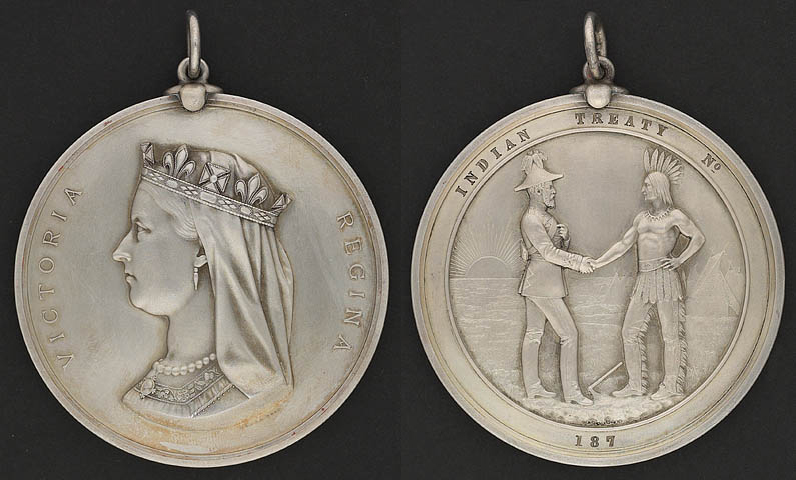Treaty 5 is also known as the Winnipeg Treaty. It was signed by Ojibwe and Swampy Cree communities around Lake Winnipeg in 1875 and 1876. Treaty 5 covers much of Manitoba and parts of Saskatchewan and Ontario.
This article is a plain-language summary of Treaty 5. If you are interested in reading about this topic more in depth, please see our full-length entry, Treaty 5.

Background
By the mid-1870s, Indigenous peoples around Lake Winnipeg wanted to sign a treaty with the federal government. They had many goals. They wanted economic help, tools and food. They also wanted to be protected from settlers. The people around Norway House wanted something more, though. They wanted to be relocated to an area in the south. The area where they lived (north of Lake Winnipeg) was not good for agriculture. By the 1870s, many people around Norway House were starving. They wanted to go south because the land was better for agriculture there. Alexander Morris also wanted to make a treaty. Morris was the lieutenant-governor of Manitoba and the North-West Territories. His goal was for Indigenous peoples to give their land to the federal government.
Treaty Negotiations and Treaty Terms
The first communities to meet with the government were the Berens River communities. They lived around Lake Winnipeg. The government was not interested in meeting with most of the communities north of the lake, except for those around Norway House. The government agreed to relocate them. Additionally, it agreed to give $5 to each person after the treaty was signed and $5 each year after. This is less money than was given to those who signed Treaties 3 and 4. As well as money, the Treaty 5 peoples would also receive land. Every family would receive 160 hectares of land. This was less than was given to those who signed Treaties 3 and 4 as well. They received less because their land was not as good for agriculture. Therefore, the government thought it was less valuable.
It took two years for this treaty to be completed. This was because government agents travelled to many different places. They wanted a variety of different communities to sign the treaty. One of the biggest problems was where to relocate the reserve land for the different communities. Adding to this problem, many communities wanted to negotiate separately from other communities. The communities had many disagreements with each other. By 1876, most of the communities around Lake Winnipeg had signed the treaty.
Adding More Communities to the Treaty
By the early 20th century, the federal government wanted to acquire more land. Much of this land was located in what is now northern Manitoba and Saskatchewan. In 1908, Cree communities at Norway House, Cross Lake and Fisher River signed the treaty. Still more Cree communities around Oxford House, God’s Lake and Island Lake signed in 1909. In 1910, the peoples around Reindeer Lake, Fort Churchill and York Factory were added to the treaty.
Problems
Treaty 5 had problems from the beginning. First, some communities were not happy with the reserve land they received. Some simply wanted more land. Moreover, the government did not fulfill all of its promises. For example, Opaskwayak Cree Nation did not receive seed, cattle and farming tools. Also, many were not happy with the schools on the reserves. Some also believed at the time, and still do, that Indigenous peoples who signed the treaty did not understand some Euro-Canadian terms of the treaty. Their worldview and the worldview of government agents was very different. Therefore, it can be argued that the Indigenous signatories did not fully understand what they were signing. The same is true of all the other Numbered Treaties as well.

 Share on Facebook
Share on Facebook Share on X
Share on X Share by Email
Share by Email Share on Google Classroom
Share on Google Classroom





